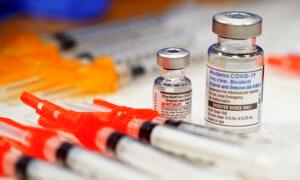The COVID-19 vaccines may weaken our ability to fight viruses at the cellular level.
Many people may be aware that neutralizing antibodies significantly wane after only a few months following COVID-19 vaccination. Newly emerging subvariants have developed a solid ability to escape from neutralizing antibodies.
However, another significant facet of the COVID-19 vaccine is that it can damage our cellular immunity, especially T-cell immunity. Cellular immunity, or cell-mediated immunity, does not involve antibodies and is pivotal in preventing the severe form of COVID-19. Recent evidence shows that after a fifth vaccine booster dose, cellular immunity waned as well.
Fifth Dose Fails to Strengthen Cell Immunity
A study, published in Frontier Immunology looked at the long-term impact of the COVID-19 mRNA vaccine on cellular immunity.
The immune responses of 61 subjects who received five doses of the vaccine were tracked from 2021 to 2023. The first four doses were the Pfizer monovalent mRNA vaccine, and the fifth dose was the Pfizer-BioNTech bivalent vaccine (Comirnaty Bivalent Original/Omicron BA.4/5).
All subjects were on hemodialysis and at high risk for severe COVID-19. The average age was 70 years. About 90 percent (55), had high blood pressure, almost half (30) had diabetes, and a smaller group of about 11.5 percent (7), had dyslipidemia, which is an abnormal amount of lipids in the blood. For their third vaccine dose, 26.2 percent of the participants (16) received a different type of vaccine booster, specifically Moderna (mRNA-1273).
The study found that while most patients maintained a strong antibody response (humoral immunity), their immune cell-based defense, as measured by interferon production T-cell immunity, weakened in many cases. After the fifth vaccine dose, only half of the patients maintained strong cellular immunity. Older participants, those aged 70 and above, were more likely to have a slightly weaker cellular immune response.
The proportion of vaccinated people who acquired cellular immunity was 75.4 percent at 10 months post-first dose, with a slight increase to 87.5 percent one month following the fourth dose; however, after the fifth dose, cellular immunity decreased significantly from 58.6 percent at one month to 50 percent at three months.
Related Stories
COVID-19 Boosters Linked to Blood Sugar Spikes in People With Type 1 Diabetes: Study
10/12/2023

Over 80 Percent of Americans Refused the Last COVID Booster: Study
10/9/2023

This finding aligns with a previous mouse study, which showed a decrease in T helper and killer cell activity and an increase in suppressive T cells after the fifth and sixth mRNA vaccine doses, suggesting evidence of immune tolerance and exhaustion.
The study confirmed that protective immune memories were overturned by extended booster vaccination by promoting adaptive immune tolerance. “We found that the protective effects from the humoral immunity and cellular immunity established by the conventional immunization were both profoundly impaired during the extended vaccination course. Specifically, extended vaccination not only fully impaired the amount and the neutralizing efficacy of serum RBD-specific antibodies, but also shortened the long-term humoral memory,” the researchers concluded.
This finding highlights the potential risks associated with continued use of SARS-CoV-2 boosters.
So, what are these immune cells doing? Why do these findings matter?
Importance of Cellular Immunity
Our immune system is composed of natural immunity and adaptive immunity. Natural immunity is the body’s inborn ability to fight off broad-spectrum infections, regardless of the specific type of virus, while adaptive immunity is the body’s second line of defense against particular invaders.
Adaptive immunity is executed by specialized immune cells that respond to specific viruses. These include lymphocytes—white blood cells such as T cells, B cells, and natural killer cells.
Our B cells are like “antibody factories” and are responsible for producing virus-specific antibodies to neutralize a virus.
T cells are a diverse group with several roles. Some act like team leaders, helping other cells do their jobs and coordinating the entire immune response; these are known as “T helper cells.” There are also “cytotoxic T cells,” known as “killer T cells,“ which specialize in destroying infected cells. Additionally, there are ”regulatory T cells,” which help regulate the immune system response by suppressing the actions of other cells.
Studies have found that new variants of SARS-CoV-2 can dodge the immune response created by mRNA vaccines, but they can’t escape T-cell-associated defense.
Interferon: A Powerful Antiviral Weapon
Cellular immunity is part of adaptive immunity that responds via T cells and B cells, etc., and mucosal immunity is part of our innate immunity (e.g., the skin and nose). Both types of immunity use interferon as a potent antiviral weapon to fight against a virus.
In mucosal immunity, when our body is confronted with a virus at the epithelial layer (surface layer of the mucosa), the epithelial cells can produce interferon, helping the cells enter an antiviral state to eradicate the virus effectively before it spreads deeply into our body. When interferon is produced naturally via our mucosa, it’s the most effective way our body eradicates a virus at the frontline. This is not possible with commonly used injected vaccinations.
In cellular immunity, interferons also act as a powerful secret weapon and play a pivotal role in antiviral immunity by eradicating pathogens.
Interferon can be reproduced by killer T cells and natural killer cells during viral infection to maximize its antiviral effects. This early and rapid increase of killer T-cell activity may explain why some people don’t experience symptoms of COVID-19 infection.
A 2023 study found that those who experienced infection had significantly lower levels of interferons compared to uninfected participants. Furthermore, participants with a significantly higher level of cellular immunity were less likely to develop breakthrough infections after vaccination.
A study published in Cell Reports shows that during the early stages of a COVID-19 infection, if a person can quickly generate SARS-CoV-2- specific T cells or interferon-producing T cells, the body can get rid of the virus faster, resulting in a less severe case of COVID-19.
The researchers analyzed the virological and immunological changes in 12 patients with acute SARS-CoV-2 infection from disease onset through recovery or death and found that patients with only mild symptoms had an early induction of interferon-gamma-secreting SARS-CoV-2-specific T cells.
mRNA Vaccines Weaken Cellular Immunity
Some may wonder how COVID-19 mRNA vaccines can suppress our cellular immunity. Here are some plausible explanations.
Spike Protein
COVID-19 vaccines bypass our body’s mucosal and vascular barriers when injected into the deltoid muscle. How our immunity responds to a vaccine will determine the impact of the vaccination.
The spike protein in mRNA vaccines is known to dysregulate our normal antiviral immunity. A study found that at 28 days after vaccination, spike protein caused consistent alteration of gene expression in peripheral immune cells, resulting in impaired interferon responses and suppressed cellular immunity, including lymphocyte and monocyte suppression.
The spike protein from the vaccine doesn’t break down quickly and can circulate in the body for over four months, which can negatively impact our immunity.
Modified mRNA
The mRNA vaccines use a slightly altered genetic code, which includes something called N1-methylpseudouridine instead of the usual uracil. This change has been found to cause regulatory T cells to activate in a way that suppresses cellular immunity.
These modified mRNA particles go to specific cells in the spleen responsible for presenting antigens without triggering necessary co-stimulatory immune responses. This will cause a decrease in the number of functioning T cells and an increase in regulatory T cells, resulting in impaired cellular immunity.
Lipid Nanoparticles
The vaccine’s ingredients include lipid nanoparticles (LNPs), tiny fat-like particles that can gather in various organs like the liver and the spleen. These LNPs, along with the mRNA they carry, can cause further inflammation, resulting in dysregulated cellular immunity.
Blood Vessel Injury
The antibodies our bodies produce in response to the vaccine’s spike protein might accidentally harm cells and tissues creating spike proteins. This includes damage to the endothelial cells, which line our blood vessels and could potentially harm organs vital to our immunity, like the adrenal gland.
Antibody-Dependent Enhancement and Immune Imprint
Another possibility known as antibody-dependent enhancement, can wreak havoc on the normal function of cellular immunity.
This could occur when the immune system’s memory of the original Wuhan-type vaccine interferes with its ability to fight off new variants, making the vaccine ineffective against these variants, potentially strengthening the COVID-19 virus’s ability to replicate.
New Variants Escape T-cell Immunity
Starting from Omicron emergence, this SARS-CoV-2 variant family has learned to escape from B cell immunity with vastly increased infectivity and immune escape from spike protein-induced antibodies. Recent variants (e.g., JN.1) have learned to mutate in the non-spike regions to escape original T-cell immunity. This could make it more challenging for our original cellular immunity to eradicate an Omicron variant.
In summary, the extensive promotion of the COVID-19 vaccine has had significant long-term negative consequences, necessitating a thorough and objective reassessment of whether we should continue to encourage vaccination among the population. Relying solely on blind faith or irrational beliefs in this context can be counterproductive and potentially harmful. Health authorities and public officials have been calling for a complete discontinuation of all mRNA vaccines.
It’s also crucial to highlight the value of non-pharmacological preventive measures and primary health education about our immune system’s role in combating viruses. There are numerous ways to holistically boost our endowed immunity based on modern biomedical research. Such knowledge is essential and should be given due attention by health authorities. This approach empowers individuals with vital information and should be a part of a comprehensive public health strategy.

